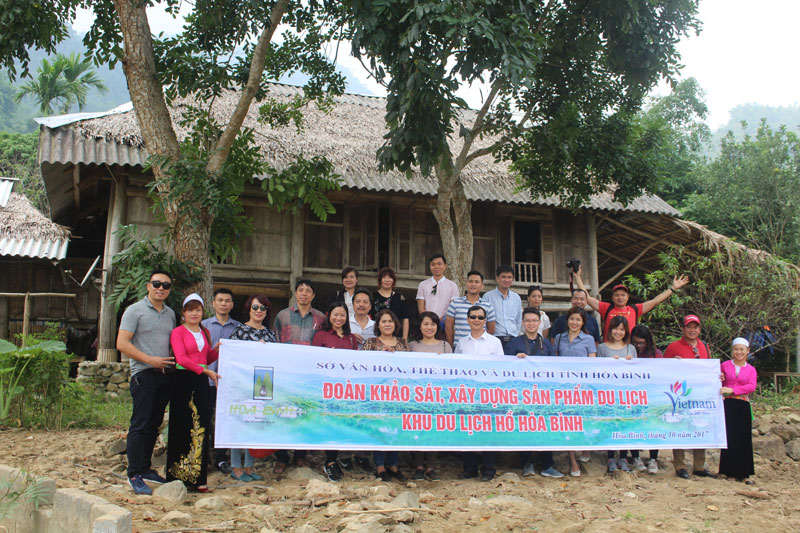
(HBO) – The Department of Culture, Sports and Tourism of the northern province of Hoa Binh recently held a familiarisation trip (famtrip) to study and develop tourism products and build a brand for the Hoa Binh Lake Tourism Area, with the participation of representatives from the Hanoi Department of Tourism and tour operators.

The famtrip
delegation explores tourist site in Ke hamlet, Hien Luong commune (Da Bac
district).
The delegation learned about the
situation in tourist destinations, including community-based tourist hamlets,
caves, springs and tourist spots in the districts of Da Bac, Mai Chau, Tan Lac
and Cao Phong, and Hoa Binh city. Of those destinations, some have been under
effective operation such as Ban Tru hamlet of Thai Thinh commune (Hoa Binh
city); Ke hamlet of Hien Luong commune and Da Bia hamlet of Tien Phong commune
(Da Bac district); Ngoi hamlet of Ngoi Hoa commune (Tan Lac district); Suoi Lon
hamlet of Tan Mai commune (Mai Chau district); and waterfalls and islands in
Hoa Binh Lake like the lake on the mountain, twin waterfalls in Trach spring,
coconut and windmill islands.
Tour operators lauded the huge
tourism potential of Hoa Binh Lake, with clear water, natural and beautiful mountains
which make picturesque landscapes, along with local people’s friendliness. Some
destinations boast professional service providers, delicious and clean food.
Although Hoa Binh Lake is wide,
vehicles travelling on the lake are limited in capacity and quality while
scattered tourism spots have yet to form routes and create long journeys to
lure visitors.
At present, food around the lake
mainly includes fish, hill chicken, local pigs and wide bamboo shoots and
vegetables, among others. They are all clean and tasty products, however,
cooking process and food arrangement remain unattractive. Additionally, there
has been no specific cuisine planning for each region, so products are still
overlapped. Some other products like brocade, rattan and bamboo products and
handicrafts have yet to be put up for sale systematically.
At the end of the trip, tour
operators affirmed that as Hoa Binh Lake boasts huge tourism potential, they
will introduce and devise new travel programmes that bring more guests to
explore the culture of local ethnic people here as well as contemplate the
pristine and spectacular beauty of the lake./.
A diverse chain of eco-tourism and resort destinations concentrated in Hoa Binh city and the districts of Tan Lac, Da Bac, and Luong Son… Along with the launch of several key high-quality resort tourism projects, these developments have reshaped the landscape and enhanced the appeal of Hoa Binh as a travel destination.
Boasting diverse terrain, a mild climate, and rich natural resources, Cao Phong district is increasingly asserting its place on Vietnam’s tourism map, attracting both domestic and foreign visitors. The district is renowned for its stunning landscapes, majestic mountains, a crystal-clear hydropower lake, and the unique cultural identity of local ethnic groups.
With its pristine landscapes, unique cultural heritage of Muong ethnic minority, and an expanding range of visitor experiences, Tan Lac district of Hoa Binh has fast become a captivating destination for both domestic and international tourists.
Until now, Sung village in Cao Son commune, Da Bac district remains the only Dao ethnic community in Hoa Binh province to develop a community-based tourism model. Beyond its untouched natural landscapes, cultural identity serves as the cornerstone attraction for visitors.
Alongside the diverse cultural identities of the Kinh, Muong, Tay, Thai, Dao, and Mong ethnic people, Hoa Binh province is also renowned as the "capital" of the northwestern Vietnamese cuisine, offering unique and distinctive dishes. At festivals, during Lunar New Year (Tet), or on significant family or community occasions, special dishes are prepared, leaving a lasting impression on visitors.
A Phong Linh (Yellow Tabebuia) flower garden in Thang village, Thach Yen commune, Cao Phong district is currently in full bloom, drawing a large number of visitors.



